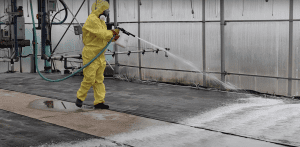Start Clean and Stay Clean
Author: Leanne Pundt
Leanne.Pundt@uconn.edu
September 2023 | Pub# EXT023
Reviewer: Rosa Raudales, Associate Professor of Horticulture & Greenhouse Extension Specialist Department of Plant Science & Landscape Architecture
It’s best not to wait until just before you start your spring seedlings, to begin cleaning, removing clutter and organizing your greenhouses. Cleaning before the crops come into the greenhouse gives us time to clean places where insect and mite pests may overwinter in unheated greenhouses, especially during warmer winters. Removing infected and infested plant debris helps prevent the spread of diseases and pests.
Remove all weeds inside that can harbor aphids, two-spotted spider mites, thrips, and whiteflies, slugs, and diseases (e.g. impatiens necrotic spot virus/tomato spotted wilt virus). Low growing weeds promote moist conditions, favoring fungus gnats, which are a primary pest during spring propagation. Weeds are also prevalent surrounding greenhouses, especially in years with extensive rainfall. It’s best to have a 10 to 20 ft. weed-free area around the greenhouse to prevent emigration of weed seeds into the greenhouse.
Cleaning is a two- step process with first removing organic matter and then applying a disinfectant labeled for greenhouse use.
First, sweep and remove all organic crop debris. Organic matter inactivates many of the disinfectants (oxidizing agents that kill fungi and bacteria). Microbes ca n also inhabit the organic debris.
n also inhabit the organic debris.
The greenhouse floor is a major source of pathogens that cause root rot and damping off diseases. Remove all plant debris, potting media, dust, and algae by sweeping the floor and then follow with a high-pressure washing. Power wash the walls first, and then work down to the benches and greenhouse floor (Figure 1).
Many growers use specific greenhouse cleaners such as Pace Strip- it Pro, which is a blend of acids, surfactants and wetting agents that can be applied with a foaming attachment removing organic matter and mineral deposits without scrubbing. Applying with a former, helps to ensure better coverage and longer contact time. Allow to sit for 5 minutes before rinsing with a high–powered hose.
After the surfaces are cleaned, you can then use a disinfectant. There are many different commercially available disinfectants developed specifically for greenhouse use. Carefully read the label of the product before use. Be sure to follow all label safety precautions including recommended rates and personal protective equipment (PPE). 
Some commercially available disinfectants include quaternary ammonium compounds or “Q salts” include Kleen Grow. Hydrogen peroxide and peroxyacetic acid products are available such as Xero Tol 2.0, Oxidate 2.0 and Sanidate which are strong oxidizing agents. Organic materials (OMRI listed products) include Oxidate, SaniDate, PERpose Plus and ZeroTol.
Use chlorine bleach with caution, as it is highly volatile, can irritate mucus membranes and lungs, and irritating to skin and eyes. It can also corrode metal. For your personal safety, it should only be used in a well-ventilated area. Mix fresh solutions every two hours because its efficacy drops, as the chlorine gas is lost at the liquid surface. Exposure to sunlight also reduces its efficacy.
It is best to use new plug trays every season. Assess the risk of re-using plug trays especially for seedlings prone to damping off and root rot diseases. Young plants are more susceptible to diseases than mature plants. Plug trays can be difficult to clean because the inside corners trap organic debris. First, power wash or brush to remove organic debris. Then, soak in a disinfectant according to label directions and then rinse with plenty of clear water.
Clean irrigation systems before re-use. Remove the emitters and flush your lines. Use a disinfectant that is labeled for use for irrigation systems and allow it to set for several hours to overnight. Run irrigation lines with plenty of clear water to clean the system.
Plan on starting clean for successful start to your spring growing season.
For more, see the following short videos on The Greenhouse Channel at UConn
Sanitation of Hard Surfaces Between Crops in Greenhouses
https://www.youtube.com/watch?v=n-016p1F6q4
Weed Control as Part of Sanitation Practices in Greenhouses
https://www.youtube.com/watch?v=eeAIB-KBPFw
References:
Chase, A. 2014. Sanitation through Disinfecting Still a Front-Line Defense. Greenhouse Product News. February 2014. https://gpnmag.com/article/sanitation-through-disinfecting-still-front-line-defense/
Copes, W.E. 2016. Sanitation for Management of Florists’ Crops Diseases. 37 pp. In Handbook of Florist Crop Diseases. Edited by R.J. McGovern and W. H. Elmer. Springer International Publishing.
Kleczewski, N. M and D.S. Egel. 2011. Sanitation for Disease and Pest Management. Purdue Extension HO-250-W. 4 pp. https://www.extension.purdue.edu/extmedia/ho/ho-250-w.pdf
Pundt, L. R. Raudales, and C. Smith. 2021-2022. New England Greenhouse Floriculture Guide. A Management Guide for Insects, Diseases, Weeds and Growth Regulators. New England Floriculture, Inc. https://greenhouseguide.cahnr.uconn.edu/
Smith, T. 2015. Cleaning and Disinfecting the Greenhouse – UMass Extension Fact sheet. https://ag.umass.edu/greenhouse-floriculture/fact-sheets/cleaning-disinfecting-greenhouse
Thomas, P. A. 2015. The Do's and Don’ts s of Using Chlorine Bleach as a Surface Disinfectant in Greenhouses. e-Gro Alert Feb 2015. 7 pp. https://www.e-gro.org/pdf/2015_406.pdf
Vance, K. 2018. How Greenhouse Sanitation helps you Start Clean and Stay Clean. Greenhouse Grower. https://www.greenhousegrower.com/production/how-greenhouse-sanitation-helps-you-start-clean-and-stay-clean/